All vinyl record-collecting enthusiasts will have found themselves at some point or another in possession of a record that simply does not want to play ball. We will be listening to a beautiful or charming song, really feeling it, then all of a sudden the needle will start to tap dance all over the disc, seemingly lost in a frenzy.
The first few times this happens it can almost feel almost unexplainable, as though your listening environment has fallen prey to a supernatural presence. It is rare that you should be able to find the time in your busy schedule to sit and listen to a whole album on vinyl, so for some ghostly presence to be playing tricks on you in this way feels wholly unfair.
There are in fact reasons for your record player skipping. It is not just some mystical presence. A skipping record comes with the territory and is inherently unavoidable. There are, however, ways to minimize the risk of your favorite discs throwing the needle off like some wild catlike beast.
Sometimes the record eventually plays ball, but other times the needle wants nothing more than to be rid of the disc for good. Here is how to get them to communicate.
Table of Contents
- Issues with the Disc Itself
- Issues with the Record Player Itself
- Final Tones
- FAQs Record Player Skipping
Issues with the Disc Itself
The main reasons and the first port of call for a record player skipping can be found within the disc itself. It is more likely to be a fault of the disc than of the turntable or record player. The disc is simply more disposable, and is designed in such a way that means it will not last as long. The materials that it is made from also mean that it often attracts many elements that are detrimental to the fidelity of the recording being played, so imbued with static electricity as it is.
1. Warps in the Disc
What with the immense pressure on vinyl record factories and plants these days as a result of the new vinyl boom, it is rare even to find a disc unmarred by warping, at least slightly. I ordered and received a copy of Hex Enduction Hour by The Fall whose disc looked more like a potato chip than a vinyl record!
Most of the time these warped records will sound fine on a good stereo system, able as the stylus is to judge these warps and peaks and troughs in real-time (though this certainly is not good for the health of your turntable).
Sometimes, however, these warps are insurmountable and/or your stylus is too tired or otherwise unable to keep up. The needle is thrown all over the place, like a cowboy on a bronco, garbed in a white shirt and bolo and waved ragged as though a flag of surrender.
This is very common these days, as I say, for various reasons. These discs are very sensitive to temperature and climate, so will warp like a flag if exposed to any warmer temperatures to prolonged periods of time. The same goes for the stacking of records on top of one another, sensitive as the disc is to any pressure or damage. Just stopping and thinking about the logical effects of your actions to your records will go a long way.
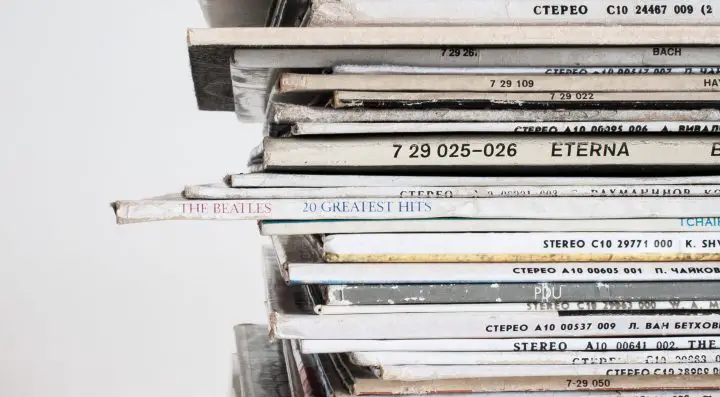
There are dedicated tools, such as record weights or record clamps which are designed in such a way as to apply enough pressure that the warps will be made more regular. This is more for the preservation of the stylus than anything else.
Prices pulled from the Amazon Product Advertising API on:
Product prices and availability are accurate as of the date/time indicated and are subject to change. Any price and availability information displayed on [relevant Amazon Site(s), as applicable] at the time of purchase will apply to the purchase of this product.
Other solutions for a record player skipping because of warping are more involved, and are more concerned with pressing the warps down physically. Proponents of this method believe that if you leave a warped record in between two large and heavy books for several weeks, the warps will be made more regular. It is recommended that you check the record’s progress each week, to see how it is getting along and how it plays.
2. Dust in the Grooves of the Record
The reason for a record player skipping might actually be as simple as dust and debris lying in the grooves of the records. So constructed, it is all too common for the grooves of a record to become marred in this way. It is almost as though they are constructed this way on purpose…
It will thus be useful to give the record(s) in question a closer inspection with a magnifying glass or some otherwise related optical device. Sometimes you might be able to see the dust with your own eye from a distance it is so obvious. Other times, such an optical device will be required to inspect the dust when it is less obvious.
Nevertheless, it is rarely a bad idea to consistently clean your vinyl record discs. There are plenty of homebrew solutions that people encourage you use, though you really can’t go wrong with a professional-grade vinyl record cleaning solution made specifically for the purpose.
This is especially wise if you are indeed intending to clean multiple records and to do so regularly. Making your own solution certainly saves money but might actually involve further damage if not total annihilation of the vinyl record disc. So proceed with caution and, if your finances allow it, invest in some dedicated solution.
Some things are best left to the professionals. They do what they are doing for a living, and have specifically designed the chemical makeup of the product for precisely this purpose.
3. Static on the Record
What can be mistaken by some as the sound of dirt and dust when a vinyl record disc is playing might actually be a significant build-up of static on the face of the disc. This form of electricity has a habit of building up a following in these kinds of technologies, that bridge the gap between analog and the digital.
Just like dirt and dust that has found a home in the grooves of the record, static electricity can cause the very same pops and skips during playback, a definite factor in a record player skipping. This is even mystifying, as it is something that you can’t see corporeally. Unlike the dirt and dust commonly found in the grooves, however, this is a fairly easy issue to address and will almost certainly not cause any damage to the record in question, not any serious damage anyhow.
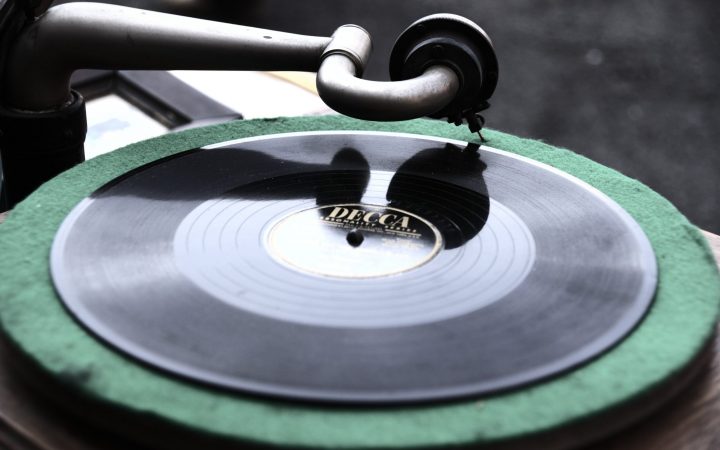
There are several popular solutions, all of which sadly involve purchasing a dedicated product for the purchase. There are such things as anti-static record sleeves that you might keep your records and sleeves in, to prevent static electricity from building up of its own accord. This has a double effect of removing a considerable amount of the static electricity accrued during playback itself.
There are also acrylic platter mats, which in the realm of playback seek to reduce the amount of static electricity conducted through the turntable to the disc itself. The chemical composition of the acrylic simply puts a relative stop to the static build-up.
Prices pulled from the Amazon Product Advertising API on:
Product prices and availability are accurate as of the date/time indicated and are subject to change. Any price and availability information displayed on [relevant Amazon Site(s), as applicable] at the time of purchase will apply to the purchase of this product.
There are other such tools which, instead of seeking to reduce build up, take it upon themselves to face the already built up static head on. The anti static carbon fiber brush, for example, is one such tool, designed to work simply by sweeping at a record, reducing static in a matter of seconds.
4. Scrapes and Scratches on a Record
Very often the reason for a record player skipping comes down to the records having not been looked after adequately. Symptoms of this will rear their heads as scratches and scrapes on the surface of a record, easily seen if viewed in a certain light. These trenches will undoubtedly spook the needle and cause it to jump excitedly forward or backward.
Sadly, this is an issue not as easily remedied. Some vinyl record collectors will tell you that it is possible to fill more dramatic holes in a record with epoxy or wood glue.
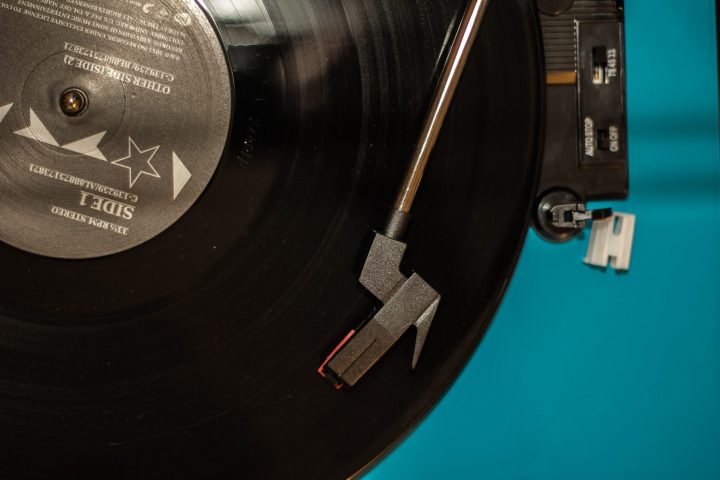
This would fill in the scratch certainly and mean that the needle would not jump. However, needles simply are not designed to grind against such materials. Marring the disc in this way is all well and good, but the needle will undoubtedly suffer for it.
Thus, the main solution here would simply be to purchase a new record, of either the same album or a different but related one, by the same artist or other proponents of the sound contained within.
Issues with the Record Player Itself
Though less likely, it is also within the realms of possibility that the record player itself is at fault. It can just as easily fall prey to certain faults and issues if not carefully tended to. For all the wonders of vinyl record collecting, the audiophilia and the hobbyist aspects, there are so many inherent faults with the medium that it is no wonder technology moved on. It is outdated technology, pure and simple, but it is our outdated technology.
5. Record Player Incorrectly Calibrated
Turntables come out of the factory with a number of specialized settings, and if you are trying to listen to a record and are left with the record player skipping, it might just be that your turntable is not calibrated quite right. More specialized turntables will come with various settings for the stylus itself.
Tracking force, for example, is how people refer to the amount of force placed on the record by a stylus. If too low, skipping is likely to occur often. Likewise, if too high, wear can occur on the disc itself and stylus, more than usual anyhow.
This tracking force can be set by adjusting the turntable in question’s counterweight to the proper specifications of the manufacturer of the stylus cartridge. The same can likewise be done with a specific turntable stylus scale to gauge the tracking force.
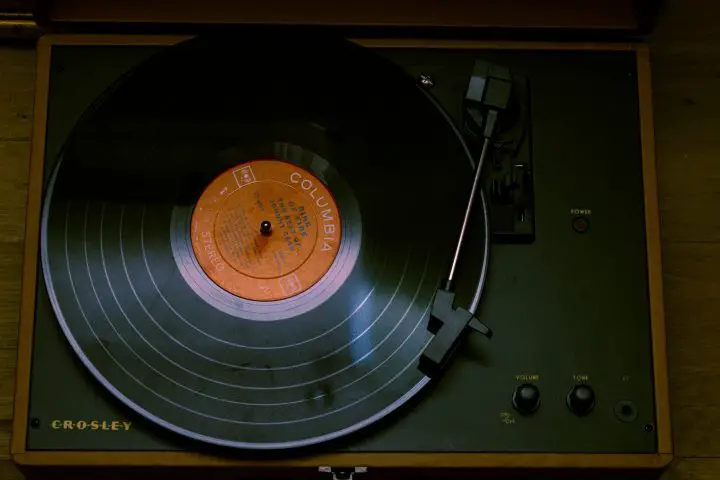
Similarly, the anti skating measures on a turntable work in the same sort of way, designed to prevent the stylus going on any unspecified excursions on the surface of the record. Thus, if your turntable is host to these settings, you will need to adjust them accordingly, either to the specifications of the manufacturer or via the information of some online resource.
6. A Dirty Needle
Much as a disc itself can act as a harbinger of dirt, dust and grime, a needle can act in precisely the same way. We have all fallen prey and witnessed it. Very often several times throughout one disc we will have to lift up the stylus and give a little blow to the dust gathering on the needle and distorting the otherwise heavenly tones being displayed.
This is, however, nothing to get too alarmed about for there are very quick and easy solutions to this issue. There are of course more homegrown solutions, though I would personally recommend using specifically designed and brewed methods, to protect the sanctity of the turntable’s components.
Prices pulled from the Amazon Product Advertising API on:
Product prices and availability are accurate as of the date/time indicated and are subject to change. Any price and availability information displayed on [relevant Amazon Site(s), as applicable] at the time of purchase will apply to the purchase of this product.
Such solutions not only come with the literal solution needed to give the needle a new lease of life so as to be able to continue serving your whim and playing the records you love. The kit also comes with the specialised tools needs to approach this very delicate component with the care and delicate attention it deserves. If you need to change your needle here is our full guide on replacing the needle on your record player.
Working with such small parts means they are far more likely to fall prey to shaky hands and clumsy gestures. Using specialized tools like this means the kind of accidents alluded to here are less likely to occur.
7. Extraneous Vibrations
This reason for a record player skipping is not really the turntable’s fault, though some do fall prey to this more than others, so make of that what you will. It is all too easy for a turntable needle and/or stylus to be jogged and interrupted in their plastic peregrinations by external vibrations. Since these can come from a variety of different places and sources, it seems that the most logical thing to do would be to work out their source.
Are there vibrations coming from within the very room that the turntable is playing in? I can’t count the amount of times someone in the same room as the record player in my house has moved too drastically or jumped and knocked the needle/stylus off kilter. These vibrations are drastic, but the skipping can be caused by much more subtle vibrations too.
Such as those transmitted through local walls, and those connected to the turntable in question. If the turntable is sharing a wall with a laundry room or a room with such vibrational technology, for example, then there is no doubt that it is going to get knocked off course every so often nor any doubt what the cause is.
If any of these things are the case and you have not got the finances to utterly sanctify your audiophilic environment, then some other adjustments will be necessary to stop the record skipping so much. Moving the turntable further away from the source of the vibrations works a treat, as does about any other common sense move in a similar vein.
If this is not possible, however, there are such devices as isolation platforms, which seek to set the turntable away from the vibrations that are perturbing it.
Prices pulled from the Amazon Product Advertising API on:
Product prices and availability are accurate as of the date/time indicated and are subject to change. Any price and availability information displayed on [relevant Amazon Site(s), as applicable] at the time of purchase will apply to the purchase of this product.
They are so constructed with sound-absorbing feet, feet that absorb and mitigate the vibrations that would otherwise knock the stylus and have the record skip.
Final Tones
Well, I hope this comprehensive guide on the various ins and outs of the reasons for a record player skipping has been helpful for you in seeking out your own reasons for why your own records are skipping.
Remember to assess the situation as singularly as you can, remembering that each circumstance is different, including your own. The reasons for your own records skipping could be any one or all of these all together, so proceed with caution and carefully considering your actions before proceeding to make decision you might in future regret.
FAQs Record Player Skipping
How do I stop my record player from skipping?
There are several primary reasons for a record player skipping, so you will have to assess each of these individually and come to your own conclusions to why your particular records are skipping: are there warps in the disc? is there dust in the grooves of the record? what about a build-up of static? or scrapes and scratches? And regarding the record player itself: is it correctly calibrated? is the needle dirty? are there external vibrations affecting playback? is the turntable on an uneven surface?
Can a bad needle cause a record to skip?
Yes, absolutely. Not only can it cause a record to skip, it can also considerably damage the record and its grooves, scratching them to dust. Your best bet is purchasing needles by reputable brands and companies, from stores dedicated to the sale of such products.


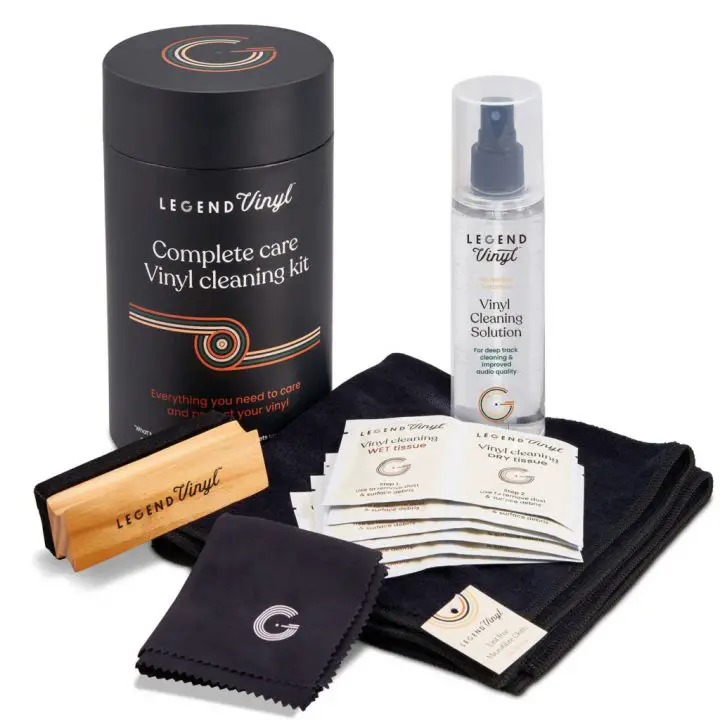
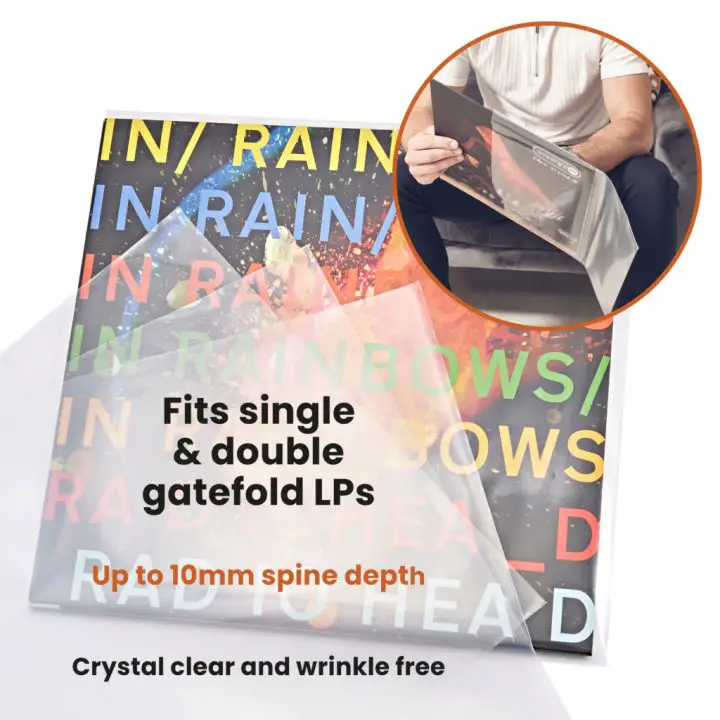
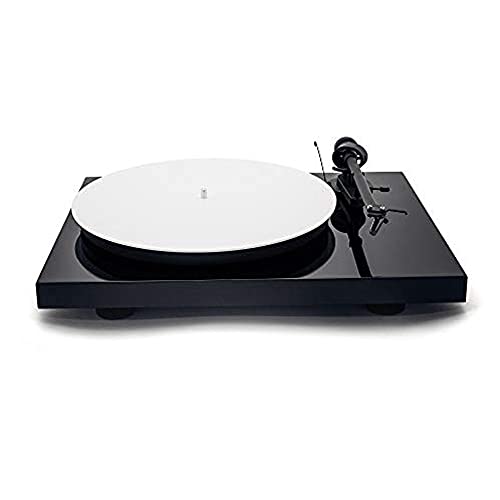


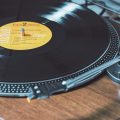

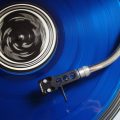


HIGHLY recommend you buy a calibration tool – scale – where you can see the weight you have on the vinyl – mine skipped like crazy and on wood floors thinking I had my weight heavier than rwmec and it was way lighter than it was recommended – only $10 – $15 investment to see exactly what weight your stylus is sitting at. Mine was eec to be 1/8 and after watching videos on how to calibrate it I was sitting at 0.5!
Hey Kurt.
You are absolutely right! Anyone who is serious about their audiophilia would do best to invest in a calibration tool of this kind. Even if you feel your turntable is fine now, you are bound one day to own another turntable that will need calibrating to the exacting standards of the resident audiophile. They are easy to use – if it doesn’t feel immediately intuitive, then you can, as you say, watch a tutorial online.
Best wishes and thanks for stopping by,
Robert.